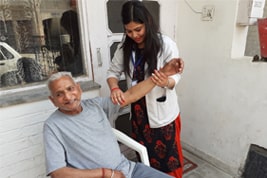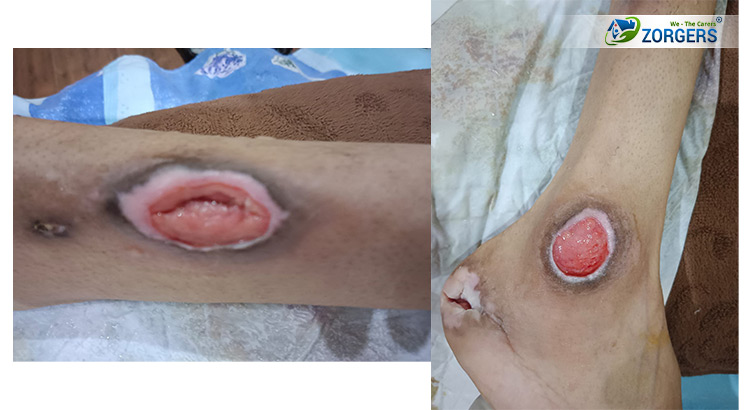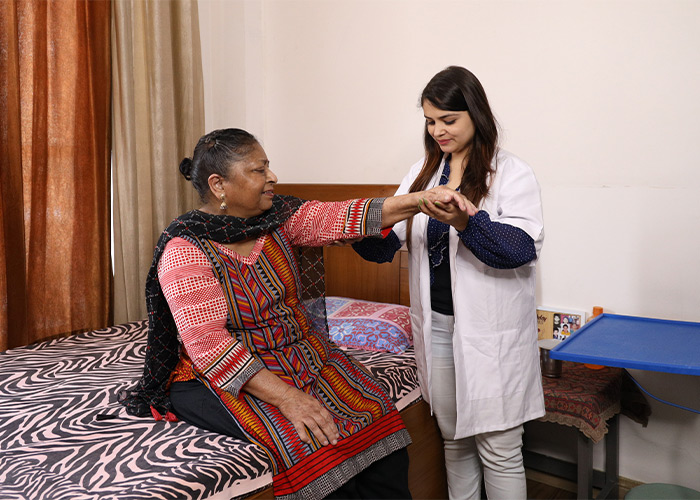Bedsores are the type of ulcers that appears on the areas of the skin which are under constant pressure from lying in the bed or even sitting throughout in a wheelchair, or sometimes as a result of procedures like plaster, etc. Bedsores are also known as pressure ulcers, pressure sores, or decubitus ulcers.
Levels of Bedsores
Any wound cannot be assigned any level. The would is said to be beyond any level when the entire tissue loss happens and the ulcer base is covered only with slough or eschar, which is found in the wound bed. In such a case, the wound area spreads largely towards the bone.
Slough usually indicate an injury to tissue and is of color like green, tan, grey, brown, or even yellow. Eschar is a thick devitalized tissue and is mostly seen as tan, brown or black in color.
What are the different signs and symptoms of bedsores?
Bedsores symptoms include:
– Tender areas of the skin along with color and texture change
– Swelling
– Pus-like drainage
– Areas with bedsores get sensitive and feel warmer or cooler than the other regions of the skin
When bedsore occur and why?
Bedsores are very common for bed-ridden patients or when a patient undergoes surgery and is bed-ridden. A bedsore is also something that is negative about ICU. People in ICU develop bedsore very often because they are constantly in the same position. And because ICU has a bad reputation in terms of infection. Shall cover appropriately.
The primary cause of bedsore is the lack of oxygen (air) towards a particular area of skin. As such bedsores can happen in any of the following cases:
– Bedridden person
– Unconscious person
– People with medical conditions with limited ability to move and change positions
– Hospitalization especially during a prolonged stay in the Intensive Care Unit (ICU)
People with conditions like diabetes and circulatory system problems are more prone to bedsores. Other important factors that cause bedsores include pressure, friction, and shear on the surface of the skin. There are certain common sites where bedsores develop with ease. Those are:
– Buttocks or tailbone region
– The underside of the arms and legs on which the body is continuously on rest without mobilization
– Shoulder blades and spine
– Occiput (Neck) region
How are bedsores treated?
Bedsores can turn out to be a serious problem since they develop quickly and takes a long time to heal and sometimes even never heal completely.
A family doctor can treat certain types of bedsores or pressure sores, however, if the condition appears to be getting severe then a specialist must be consulted for the same. Such specialists might include nutritionists, critical-care physicians, neurologists, geriatricians, general surgeons, and even plastic surgeons.
In most cases, a patient needs the attention of various specialists under a different system of medicines to cure the overall problem related to bedsores. Specific treatment can be suggested by the healthcare provider based on the severity of bedsores after evaluation of its size, and depth. The treatment becomes difficult once the layer of the skin gets broken.
The treatment includes some of the following basic principles:
– Removal or reduction of pressure on the affected region by increased mobility with switching positions and providing appropriate mattresses
– Oxygen therapy
– Removal of damaged, infected, or dead tissue
– Skin grafting
– Medication therapy involving antibiotics to treat infections
– Treating underlying problems like diabetes, anemia, etc.
– Fecal or urine incontinence management
The best possible treatment applications can be discussed with the doctor. However, ensuring proper nutrition and keeping wounds clean must be followed on a routine basis. Immediate precautions and treatment of bedsores usually help in nearly 70% to 90% stage I and II cases in avoiding any surgical interventions. Reducing pressure, changing body position frequently and keeping wounds clean helps in quick healing of the bedsores without any further worsening of the condition.
What steps must be kept in mind for bedsores at-home care?
Besides hiring a trained healthcare professional to look after the patient with bedsores, there are certain things that must be kept in mind regarding bedsores during home care treatment. These are as follows:
– Mainly for level I bedsores it is advised to wash the sores with mild soap and water and apply a medicated and recommended moisturizer to build a barrier from body fluids.
– For stage II bedsores cleaning with saltwater or saline is a must for removal of any loose or dead tissue. Any prescribed cleanser can also be used if provided by the doctor.
– Cleansers contain iodine or hydrogen peroxide must not be used as they damage the skin.
– Routinely dressing is a must along with keeping the sore covered with that special dressing. It minimizes the chances of infection and helps in quick healing.
– Dressing must be done as per the doctor’s instructions using the allowed gauze, gel, film, foam, etc. as per the stage of the bedsores.
– A further balanced diet with high protein content can help in reducing recurrent bedsores.
Why professional nursing care is a must for level 3 and 4 bedsores?
Normally, it is advisable especially for type II to IV bedsores that it must be taken care of by healthcare professionals. So, these days hiring professionally trained medical professionals such as a nurse or doctor is effective through home nursing service providers like Zorgers. This is essential because:
– A level 3 and 4 bedsores involve major skin and tissue loss.
– Loss of the dermal layers involving skin, muscles, tendons need constant supervision during the healing process, and it can only be provided by a home nurse visit.
– Any signs of infection or worsening of the sores can be analyzed by a visiting nurse especially in cases of failure of skin grafting or medical debridement which is done many times in level 4.
If not monitored on a regular basis by a healthcare professional like a nurse the bedsores can even transform into a fatal condition risking the life of the patient. Since a nurse can always inform the doctor of any serious condition developing on a time which can minimize the risk of life.
Some of the basic rules which a professionally trained nurse will apply in looking after the patient with bedsores include:
– Proper cleaning of the affected region from washing to dressing using the appropriate and prescribed method.
– Helps in further pressure reduction by carefully switching the position of the patient avoiding any slipping or sliding, as per the recommended time while in bed or wheelchair.
– Taking care of the daily nutrition and medicines which, a patient has to eat for quick healing.
– Avoiding any further injury or friction to the sores by lightly powdering the sheet from time to time.
– Checking the sores on a daily basis and monitoring size and depth and informing the doctor routinely about the condition.
Can bedsores be prevented?
Bedsores can certainly be prevented by inspecting the skin on a regular basis for areas of redness which is mainly an initial sign of breakdown. Special attention must be given to the bony areas every day to keep a check on bedsores.
Further, some of the methods are listed below to prevent bedsores and its further worsening in a person:
– Ensure positioning and turning a bedridden person every 2 hours
– Making a person sit straight and upright every 15 minutes while on a wheelchair
– Provide soft padding in beds and wheelchairs to reduce pressure which minimizes chances of bedsores
– Ensure a proper routinely good skincare to keep the skin clean and dry
– Proper nutrition is a must including enough vitamins, minerals, calories, fluids, and proteins, etc.
– Proper awareness and in-depth education about bedsores are also important in order to prevent the condition and any healthcare professional can easily assist with the same
– Knowledge and skill sets can be provided via training to a caretaker who can be hired for at-home services to look after for a loved one and help in quick healing of bedsores or entirely minimize its chances of occurrence with proper care and precautions.









Thanking you for sharing the great information’s. This was an useful blog for Care Coimbatore is one of the leading primary health care service center providers in and around Coimbatore, based on measures of patient safety, quality, cost, patient satisfaction and staff engagement